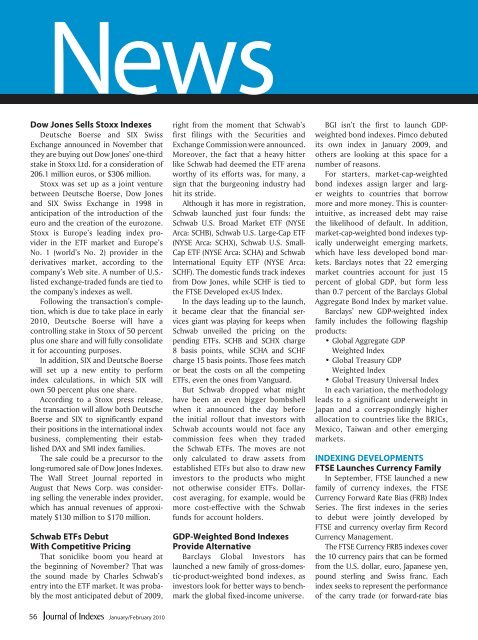Download - IndexUniverse.com
Download - IndexUniverse.com
Download - IndexUniverse.com
You also want an ePaper? Increase the reach of your titles
YUMPU automatically turns print PDFs into web optimized ePapers that Google loves.
News<br />
Dow Jones Sells Stoxx Indexes<br />
Deutsche Boerse and SIX Swiss<br />
Exchange announced in November that<br />
they are buying out Dow Jones’ one-third<br />
stake in Stoxx Ltd. for a consideration of<br />
206.1 million euros, or $306 million.<br />
Stoxx was set up as a joint venture<br />
between Deutsche Boerse, Dow Jones<br />
and SIX Swiss Exchange in 1998 in<br />
anticipation of the introduction of the<br />
euro and the creation of the eurozone.<br />
Stoxx is Europe’s leading index provider<br />
in the ETF market and Europe’s<br />
No. 1 (world’s No. 2) provider in the<br />
derivatives market, according to the<br />
<strong>com</strong>pany’s Web site. A number of U.S.-<br />
listed exchange-traded funds are tied to<br />
the <strong>com</strong>pany’s indexes as well.<br />
Following the transaction’s <strong>com</strong>pletion,<br />
which is due to take place in early<br />
2010, Deutsche Boerse will have a<br />
controlling stake in Stoxx of 50 percent<br />
plus one share and will fully consolidate<br />
it for accounting purposes.<br />
In addition, SIX and Deutsche Boerse<br />
will set up a new entity to perform<br />
index calculations, in which SIX will<br />
own 50 percent plus one share.<br />
According to a Stoxx press release,<br />
the transaction will allow both Deutsche<br />
Boerse and SIX to significantly expand<br />
their positions in the international index<br />
business, <strong>com</strong>plementing their established<br />
DAX and SMI index families.<br />
The sale could be a precursor to the<br />
long-rumored sale of Dow Jones Indexes.<br />
The Wall Street Journal reported in<br />
August that News Corp. was considering<br />
selling the venerable index provider,<br />
which has annual revenues of approximately<br />
$130 million to $170 million.<br />
Schwab ETFs Debut<br />
With Competitive Pricing<br />
That soniclike boom you heard at<br />
the beginning of November? That was<br />
the sound made by Charles Schwab’s<br />
entry into the ETF market. It was probably<br />
the most anticipated debut of 2009,<br />
right from the moment that Schwab’s<br />
first filings with the Securities and<br />
Exchange Commission were announced.<br />
Moreover, the fact that a heavy hitter<br />
like Schwab had deemed the ETF arena<br />
worthy of its efforts was, for many, a<br />
sign that the burgeoning industry had<br />
hit its stride.<br />
Although it has more in registration,<br />
Schwab launched just four funds: the<br />
Schwab U.S. Broad Market ETF (NYSE<br />
Arca: SCHB), Schwab U.S. Large-Cap ETF<br />
(NYSE Arca: SCHX), Schwab U.S. Small-<br />
Cap ETF (NYSE Arca: SCHA) and Schwab<br />
International Equity ETF (NYSE Arca:<br />
SCHF). The domestic funds track indexes<br />
from Dow Jones, while SCHF is tied to<br />
the FTSE Developed ex-US Index.<br />
In the days leading up to the launch,<br />
it became clear that the financial services<br />
giant was playing for keeps when<br />
Schwab unveiled the pricing on the<br />
pending ETFs. SCHB and SCHX charge<br />
8 basis points, while SCHA and SCHF<br />
charge 15 basis points. Those fees match<br />
or beat the costs on all the <strong>com</strong>peting<br />
ETFs, even the ones from Vanguard.<br />
But Schwab dropped what might<br />
have been an even bigger bombshell<br />
when it announced the day before<br />
the initial rollout that investors with<br />
Schwab accounts would not face any<br />
<strong>com</strong>mission fees when they traded<br />
the Schwab ETFs. The moves are not<br />
only calculated to draw assets from<br />
established ETFs but also to draw new<br />
investors to the products who might<br />
not otherwise consider ETFs. Dollarcost<br />
averaging, for example, would be<br />
more cost-effective with the Schwab<br />
funds for account holders.<br />
GDP-Weighted Bond Indexes<br />
Provide Alternative<br />
Barclays Global Investors has<br />
launched a new family of gross-domestic-product-weighted<br />
bond indexes, as<br />
investors look for better ways to benchmark<br />
the global fixed-in<strong>com</strong>e universe.<br />
BGI isn’t the first to launch GDPweighted<br />
bond indexes. Pimco debuted<br />
its own index in January 2009, and<br />
others are looking at this space for a<br />
number of reasons.<br />
For starters, market-cap-weighted<br />
bond indexes assign larger and larger<br />
weights to countries that borrow<br />
more and more money. This is counterintuitive,<br />
as increased debt may raise<br />
the likelihood of default. In addition,<br />
market-cap-weighted bond indexes typically<br />
underweight emerging markets,<br />
which have less developed bond markets.<br />
Barclays notes that 22 emerging<br />
market countries account for just 15<br />
percent of global GDP, but form less<br />
than 0.7 percent of the Barclays Global<br />
Aggregate Bond Index by market value.<br />
Barclays’ new GDP-weighted index<br />
family includes the following flagship<br />
products:<br />
• Global Aggregate GDP<br />
Weighted Index<br />
• Global Treasury GDP<br />
Weighted Index<br />
• Global Treasury Universal Index<br />
In each variation, the methodology<br />
leads to a significant underweight in<br />
Japan and a correspondingly higher<br />
allocation to countries like the BRICs,<br />
Mexico, Taiwan and other emerging<br />
markets.<br />
INDEXING DEVELOPMENTS<br />
FTSE Launches Currency Family<br />
In September, FTSE launched a new<br />
family of currency indexes, the FTSE<br />
Currency Forward Rate Bias (FRB) Index<br />
Series. The first indexes in the series<br />
to debut were jointly developed by<br />
FTSE and currency overlay firm Record<br />
Currency Management.<br />
The FTSE Currency FRB5 indexes cover<br />
the 10 currency pairs that can be formed<br />
from the U.S. dollar, euro, Japanese yen,<br />
pound sterling and Swiss franc. Each<br />
index seeks to represent the performance<br />
of the carry trade (or forward-rate bias<br />
56<br />
January/February 2010
















